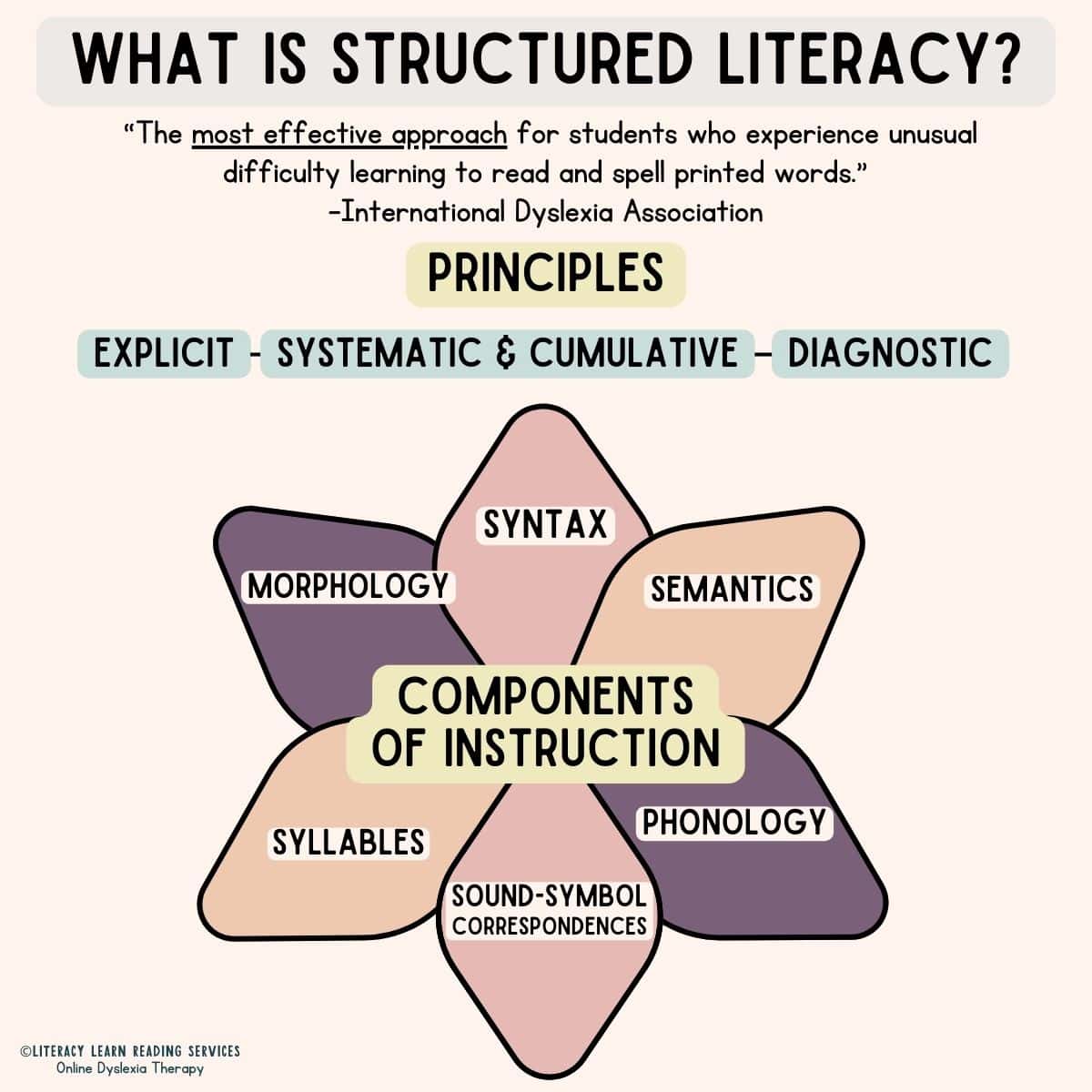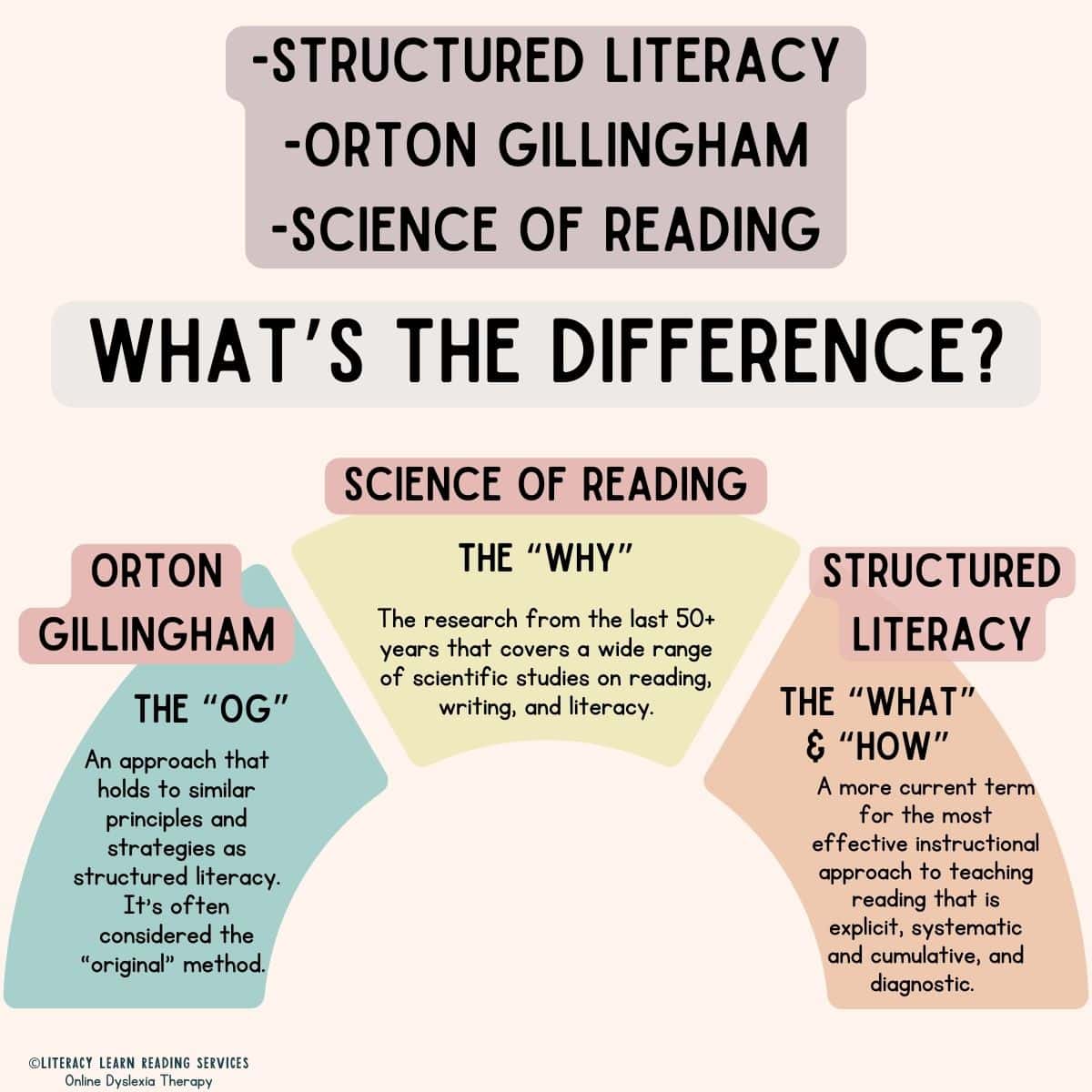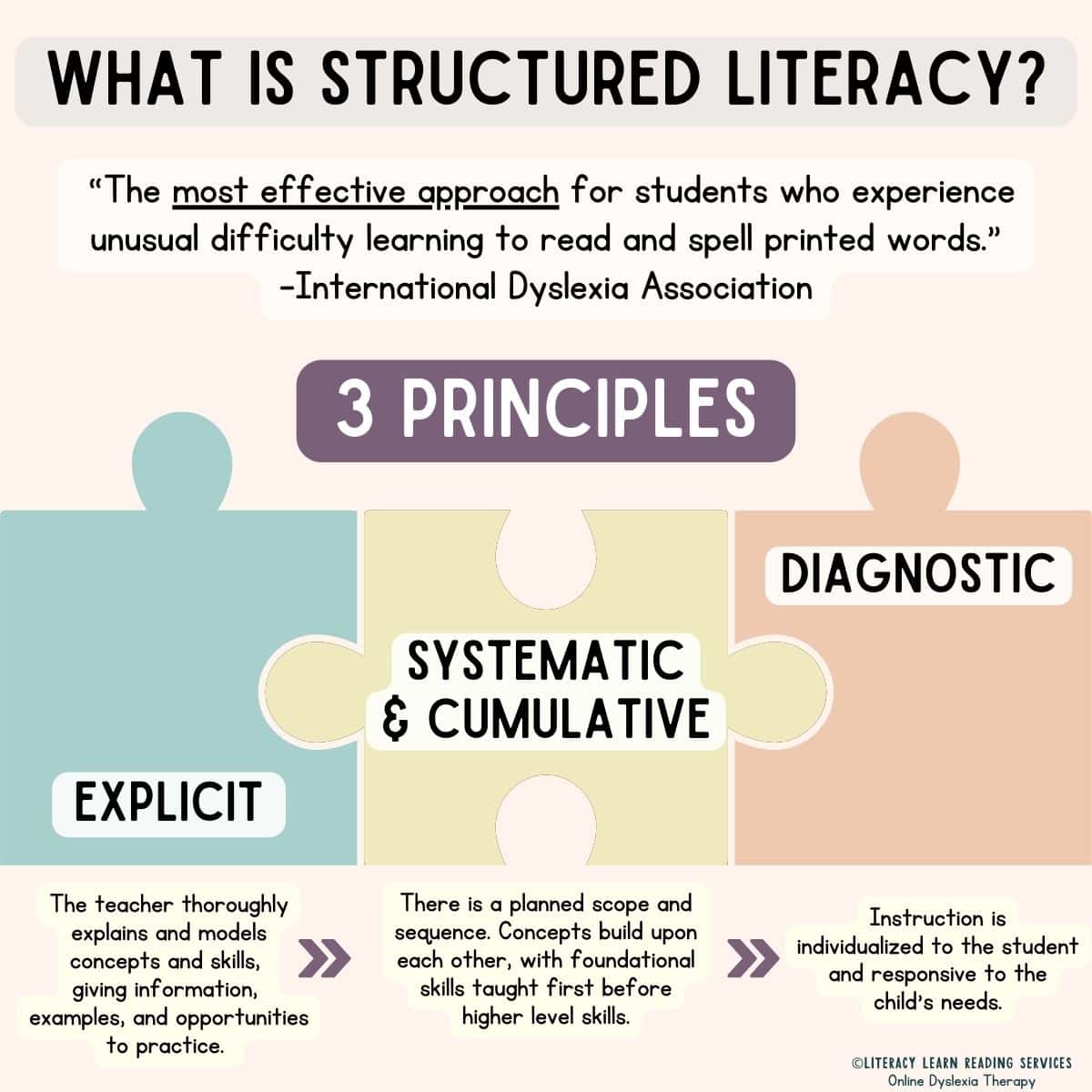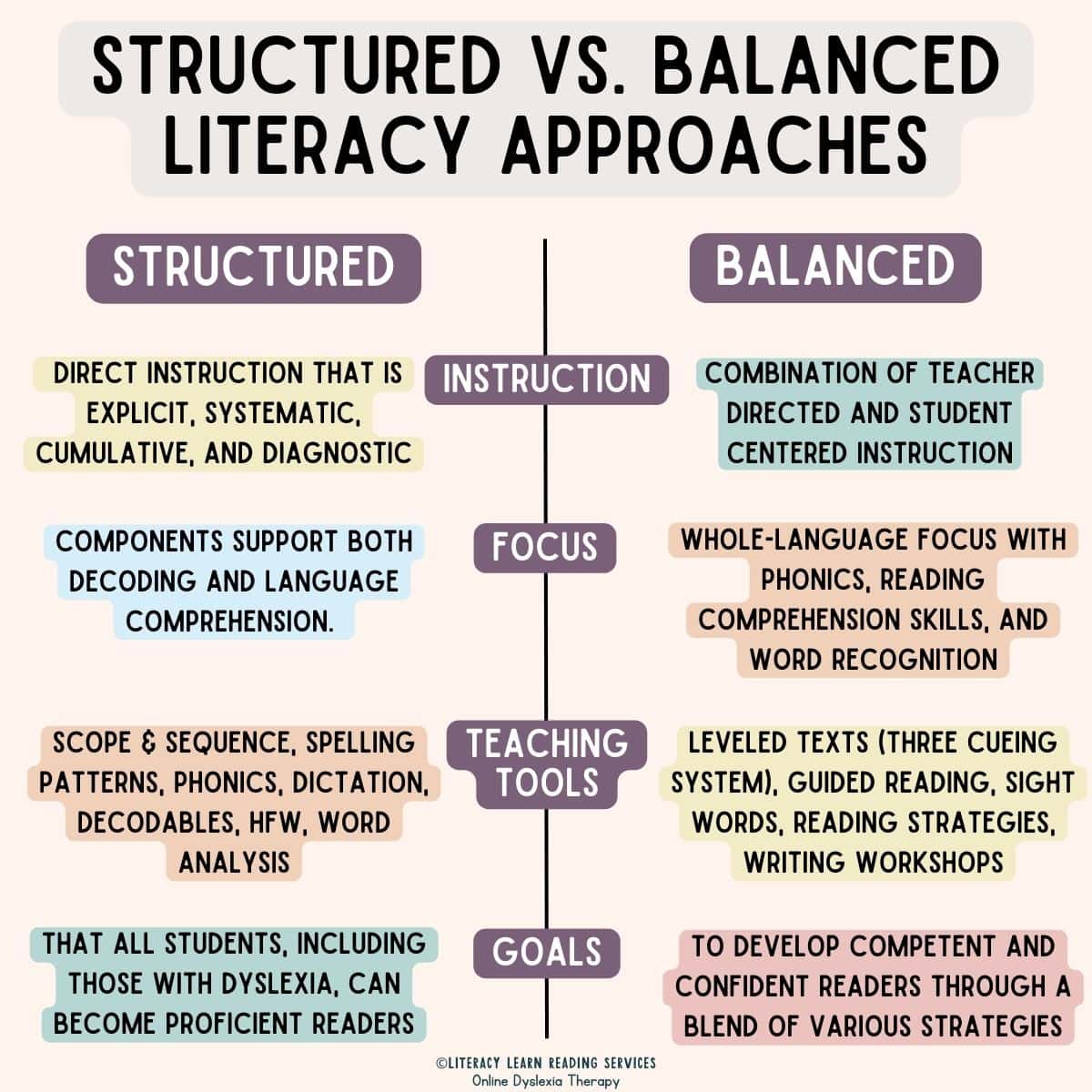How Structured Literacy Helps Struggling Readers
This post may contain affiliate links. As an Amazon affiliate, we earn from qualifying purchases.
Learn about the principles and components of Structured Literacy, the most effective approach for helping struggling readers and writers. Explore why it works and how it’s different from Balanced Literacy.

This post is sponsored by Lexercise. All opinions are our own!
📚 Take a free Dyslexia Screener and learn more about Dyslexia Therapy options for struggling readers and writers!
What Is Structured Literacy?
Structured Literacy is an instructional approach to teaching reading that is explicit, systematic and cumulative, and diagnostic.
You might’ve heard it go by a different name, like Orton-Gillingham or the Science of Reading. Let’s quickly review these commonly used terms because there are strong connections between them.

👉 Orton Gillingham (OG) is an approach that holds to similar principles and strategies for research-based literacy instruction. It’s often considered the “original” method.
👉 Structured Literacy framework encompasses a bit more than the OG approach, so Structured Literacy has become the more widely recognized term today.
👉 Science of Reading is the body of research from the last 50 years that covers a wide range of scientific studies on reading, writing, and literacy.
Basically, the Science of Reading is the “why,” while Structured Literacy is “what” and “how.”
3 Principles of Structured Literacy

Diagnostic
The diagnostic principle of structured literacy instruction means it is individualized and responsive to the child’s needs and based on data.
Explicit
Explicit instruction means the teacher clearly and thoroughly explains and models concepts and skills, giving the child information, examples, and opportunities for exposures and to practice.
Systematic & Cumulative
Structured literacy should be systematic and cumulative, meaning there is a planned scope and sequence. Concepts build upon each other, with foundational skills taught first before higher-level skills.
6 Components of Structured Literacy Instruction

Phonology
Phonology is the study of the sound structure in spoken words. Key components of phonology are phonological awareness and phoneme awareness.
Phoneme awareness is the ability to recognize and work with the individual sounds (phonemes) in spoken words. Being able to hear, identify, and work with the sounds that make up words is an essential skill for reading success.
👉 For example:
- Segmenting the individual speech sounds in the word cat: /k/ /a/ /t/.
Sound-Symbol Correspondences
This refers to the relationship between the sounds we hear in words and the letters or letter combinations that represent those sounds.
It’s essential to be able to match sounds to letters for both reading and spelling success.
👉 For example (reading):
- Seeing the written letters in a word like map and connecting them to their sounds for reading: map = /m/ /a/ /p/.
👉 For example (spelling):
- Isolating the individual speech sounds and writing the letters that represent those sounds in the correct order: /m/ /a/ /p/ = map.
(Learn more about the terms phonemes and graphemes (and morphemes, too) and the important process orthographic mapping has in connecting sounds and symbols.)
Syllable Instruction
Because every syllable in English includes a vowel sound, instruction in the six syllable types is helpful for pronouncing and spelling the vowel sound in a syllable.
👉 For example:
- Volcano is a three-syllable word (because it has three vowel sounds).
- Let’s break it into syllables: vŏl-cā-nō = vol is a closed syllable (short vowel sound) and both ca & no are open syllables (long vowel sounds).
Morphology
Morphology is the study of how words are formed. It looks at the smallest meaningful word parts, called morphemes.
Morphemes can be bases, prefixes, and suffixes. Morphology investigates how word parts are combined to change the words and express different meanings.
👉 For example:
- There are three morphemes in the word unlucky – un + luck + y.
- The prefix un- means not, and changes the meaning to negative.
- The base is luck and means good fortune.
- The suffix -y means inclined to.
- The literal meaning is “not inclined to good fortune.”
Syntax
This is the set of rules that tells us how to arrange words in a sentence. It includes grammar, mechanics, sentence structure, and considers how language works.
👉 For example:
- Correct: The cat chased the mouse.
- Incorrect: cat the Mouse chased.
Semantics
Semantics is the study of meaning in language. It’s all about understanding what words, phrases, and sentences mean in various contexts and how we use them to communicate..
👉 For example: “I’ll be there in a jiffy.”
- Literal meaning: “Jiffy” is a very short period of time.
- Implied meaning: The speaker is likely saying they will arrive soon, but not immediately.
How Is Structured Literacy Different from Balanced Literacy?

Schools have used a balanced literacy approach for years, but lately, more people are paying attention to what research says about how kids really learn to read.
Now, the focus is shifting toward structured literacy, which has some similarities but also key differences.
Balanced literacy assumes that kids will naturally pick up reading skills when exposed to lots of books. It attempts to blend whole language and phonics, but often does so in an incomplete and indirect way.
Core balanced literacy teaching tools include using leveled texts, guided reading, sight word memorization, various reading strategies, writing workshops, and an occasional disconnected phonics lesson.
Balanced literacy works for some students, mostly those who would learn to read no matter what instructional method is provided, but it leaves many behind—particularly kids with dyslexia or other reading challenges.
Structured literacy, on the other hand, is based upon research that tells us how kids learn to read proficiently. It includes three main principles and six essential components.
👉 Read more about reading instruction to find out what works and what doesn’t.
How Does Structured Literacy Help Kids?
The International Dyslexia Association (IDA) says that Structured Literacy instruction is, “the most effective approach for students who experience unusual difficulty learning to read and spell printed words.”
It helps students develop strong foundational reading skills through explicit instruction of the rules and patterns of language, with lots of opportunities for practice and reinforcement.
Because it provides clear and direct instruction in a cumulative and sequential way, structured literacy instruction allows all kids to build upon their literacy skills step-by-step. They master the basics before moving on to more difficult concepts.
For kids with reading and writing struggles, Structured Literacy instruction is empowering! It gives kids the tools they need to “crack the code,” building essential connections and pathways in their brains.
And ultimately, it enables kids to have success with literacy and learning.
A Call to Teachers
“A highly knowledgeable and skilled teacher of reading, NOT a curriculum, teaches a child to read. According to a wise pioneer in the field of dyslexia, ‘A teacher who knows what to teach and how to teach it could use a stick in the sand to teach a dyslexic child to read.’ A good curriculum just makes the process even better!”
-IDA Dyslexia Handbook
I spent years as a Title 1 reading specialist, working with the same kids, sometimes from kindergarten through fifth grade. I taught with a balanced literacy approach using the LLI curriculum.
Just last week, I ran into some of my former students, now in high school (towering over me!), and I couldn’t help but wonder, “Would their lives be different now if I’d taught them using structured literacy then?”
While I can’t change the past, I can learn from it. When we know better, we do better—so let’s keep learning about structured literacy!
Benjamin Franklin said, “An investment in knowledge pays the best interest.”
Knowledge of structured literacy will empower you to become a skilled and expert teacher. And it will certainly empower your students with the skills they need for lifelong success.
To learn more, I suggest taking these online Professional Development courses from Lexercise (I’ve taken them myself!). They’re self-paced, affordable, and chock full of amazing, research-based information!
- Course 1: The Structure of Written English
- Course 2: Multisensory Structured Literacy Interventions
- Course 3: Practicum in Structured Literacy Therapy (IDA PLUS Accredited!)
And if you’re an administrator looking for a curriculum to help make the process even better, check out Lexercise for Schools.
The knowledge I’ve gained from my Lexercise courses has profoundly shaped me into a skilled and knowledgeable teacher. Read more about my training and the practicum experiences!
Now, as a Certified Structured Literacy Dyslexia Specialist (C-SLDS), I provide Dyslexia Therapy to children with reading and writing struggles. I get to witness their remarkable successes— transformations I could only have dreamed of in the past!

🙏 Thank you to our trusted partner Lexercise for helping us spread awareness about dyslexia and Structured Literacy this month!
Be sure to check out the other installments of this informational series:
- What is Dyslexia? Characteristics, Definitions, Resources, and More
- Hidden Dyslexia Symptoms: The Dyslexia Iceberg
- Debunking Dyslexia Myths
Further Learning:
- Shifting the Balance by Jan Berkins
- Here’s Why Schools Should Use Structured Literacy by Louise Spear-Swerling, PhD
- Structured Literacy Instructions: The Basics by Reading Rockets
- Sold a Story: How Teaching Kids to Read Went so Wrong. Podcast by Emily Hanford
- Know Better, Do Better by Meredith and David Liben

